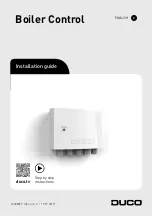
Domestic Hot Water
Commence by opening a hot tap near to the appliance.
Gradually close the hot tap and check that the burner pressure
drops. Fully open the tap and check that the burner pressure
rises. Fully close the tap and check that the burner goes off. The
fan may continue running until the appliance has cooled to a
pre-set temperature.
Central Heating
Set the mode switch to the normal position.
Check that all the radiator valves are open. Set the room
thermostat and the Central Heating Temperature Control to
maximum.
Check that the sealed system is pressurised and set to the
required pressure as indicated on the gauge.
Set the Operating Switch (and Programmer) to
HEATING and
WATER.
Turn on the gas and electricity supplies.
The burner will light.
The appliance will modulate its output between 6.7 and 26.0 kW
(in condensing mode) over a period of about two minutes.
Check the system to ensure that all the radiators are heating up
evenly.
Shut down all but one of the radiators and observe the burner
pressure fall. Open all of the radiator valves and check that the
burner pressure rises.
Balance the system so that the required temperature difference
across the central heating flow and return pipes is obtained.
Refer to Section 3, Table 3.
Adjust the central heating by-pass valve until the same
temperature difference is obtained. See fig. 30. This should be
carried out with only a single radiator operating. If thermostatic
radiator valves are fitted then one radiator should be left
uncontrolled.
The by-pass valve should never be fully closed.
Set the room thermostat to minimum and check that the burner
goes out. Reset the room thermostat to maximum and the
burner will re-light and follow the normal operating procedure.
Check for proper ignition of the burner after a break in the gas
supply:
Turn off the gas service cock and wait for 60 seconds. The burner
will go out but sparking from the electrode will continue for 10
seconds when the appliance will enter a ‘lockout’ state. Carefully
open the gas service cock, press the lockout reset button and
observe the burner re-light and follow the normal sequence of
operation.
Set the Operating Switch to
OFF.
Turn off the gas service cock and the electrical supply to the
appliance.
Drain the system while the appliance is still hot.
Refill, vent and re-pressurise the seled system as described in
Section 11.1.
Domestic Hot Water and Central Heating
Set the gas valve mode switch to the normal position.
Turn on the electricity supply to the appliance and open the gas
supply cock at the appliance.
Set the Operating Switch (and Programmer) to
HEATING and
WATER
. If a programmer is fitted, set the domestic hot water to
Continuous or 24Hrs and the central heating to
ON
. The burner
will light and heat will pass into the system. Turn on a hot water
tap and check that fully heated hot water is discharged from the
tap.
Close the tap and the burner will go off. The appliance will then
return to the central heating mode and automatically balance
with the system requirements. Set the Operating Switch to
OFF
and the burner will go out.
After 30 minutes of running, turn the appliance off and remove
the inner casing cover.
Check there are no condensate leaks from the fan outlet, flue
turret, flue hood joints and the flue system. Ensure there are no
leaks from the condensate drainage system.
Disconnect the pressure gauge and tighten the test point screw.
Restart the appliance and check for gas soundness around the
test point screw.
Refit the facia and two fixing screws and cabinet front panel.
If the appliance is being passed over to the user immediately
refer to Section 13 - ‘Instructions to the User’ and set the controls
to the user’s requirements. See fig. 31.
If the appliance is to be left inoperative, check that the Operating
Switch is set to
OFF
. Turn off the gas service cock and switch off
the electricity supply.
If there is any possibility of the appliance and system being left
inoperative during frosty conditions, drain the appliance and
system. If the premises are to be left unoccupied during frosty
conditions, then drain the appliance and system.
For short inoperative periods, leave the appliance under the
control of the built in frost thermostat or the remote frost
thermostat (if fitted) or leave operating continuously with the
room thermostat set at 6°C.
See fig. 31.
12.1
Tell the user how to operate the appliance and hand over
the Users Instructions leaflet.
12.2
Tell the user what to do if the heating system is not to be
used in frosty weather.
12.3
Tell the user the sealed system set pressure.
12.4
Tell the user of the importance of regular servicing.
Worcester Heat Systems Ltd. offer a comprehensive maintenance
contract.
12.5
Set the system controls to the user’s requirements.
12. Instructions to the User
11.5 Completion of Commissioning
11.4 Condensate Check
22
Fig. 30. Central heating by-pass adjustment.
Central Heating by-pass
adjustment screw
Содержание 26CDi Xtra
Страница 35: ...35 96 NG OR LPG NG OR LPG 109 201 ...
Страница 47: ...47 ...
















































